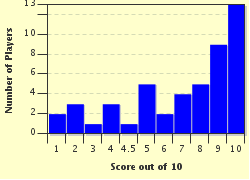Quiz Answer Key and Fun Facts
1. What is the biggest difference between baritones and euphoniums?
2. Euphoniums are non-transposing instruments, meaning the note sounded is the same as the note written. Which of these instruments is most often a transposing instrument?
3. Which is NOT a number of valves a baritone or euphonium can have?
4. Which clef are baritones and euphoniums least likely to play in?
5. Euphoniums and baritones are most similar in range to
6. Literally speaking, what does the name euphonium mean?
7. Can there ever be different fingerings for a single note?
8. What is circular breathing?
9. What are pedal notes?
10. Where on the staff is the pedal B flat located on a C euphonium or baritone in bass clef?
Source: Author
maddielc
This quiz was reviewed by FunTrivia editor
ertrum before going online.
Any errors found in FunTrivia content are routinely corrected through our feedback system.

